EVGA X58 Classified - First Look
by Rajinder Gill on February 27, 2009 5:00 AM EST- Posted in
- Motherboards
The Wet Stuff
We used water-cooling for our 24/7 stability runs. This is the same configuration we used when testing the EVGA X58 SLI. Using our i7-920 CPU, we were determined to find the maximum Prime95 stable overclock achievable on both boards by using the 19x multiplier (for BCLK addicts) and later the 21x multiplier to find the limits in raw CPU frequency. It is not surprising that both boards managed to overclock pretty close to one another considering our cooling system. The main differences between the boards are when we installed three GTX 280 cards along with a 6GB (3x2GB) memory configuration.
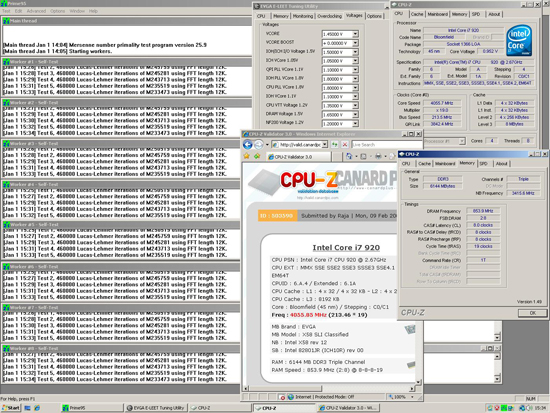
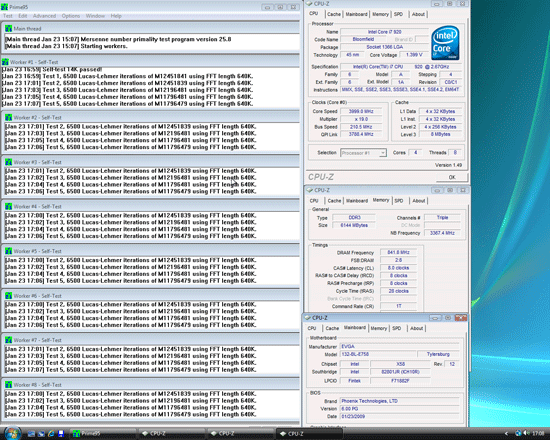

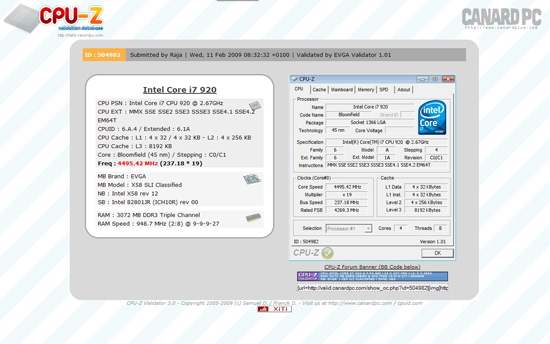
It's mostly academic, but the Classified pulls away by a small margin with 6GB of memory installed, although both boards will run 3x1GB at 215 BCLK. The EVGA X58 SLI board would not run any 8-thread CPU or 3D tests past 215 BCLK for us, while the Classified happily chugs along at 222 BCLK for 3DMark06 and 3DMark Vantage while retaining full stability in other applications. We could increase BCLK up to 227 for suicide runs in these particular benchmarks, but this would create stability problems in other programs.
The Cold Stuff
We used a test room with low ambient temperatures (16C) for the following benchmarks. We used water-cooling when the CPU was operating at 4.5GHz or below and Cascade cooling for benchmarks over this processor speed.
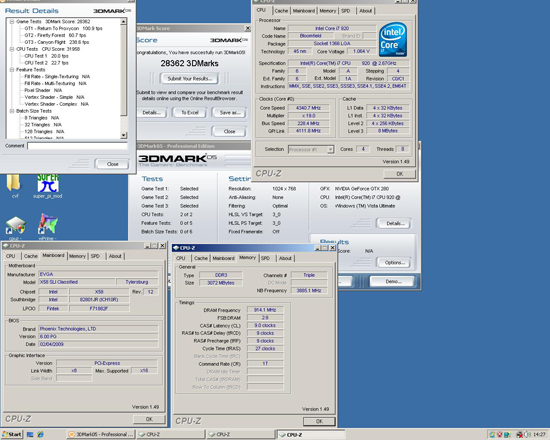
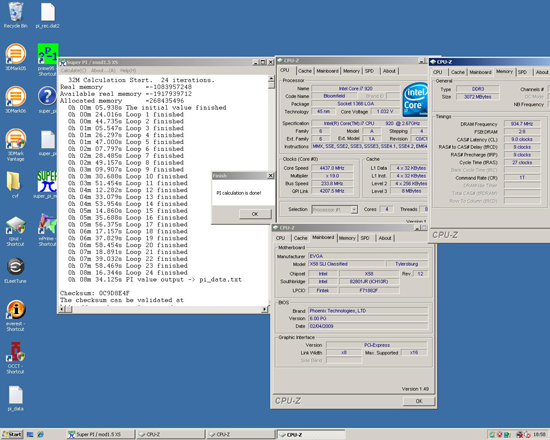
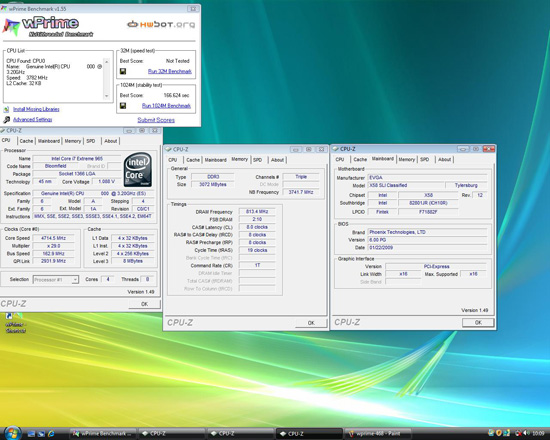
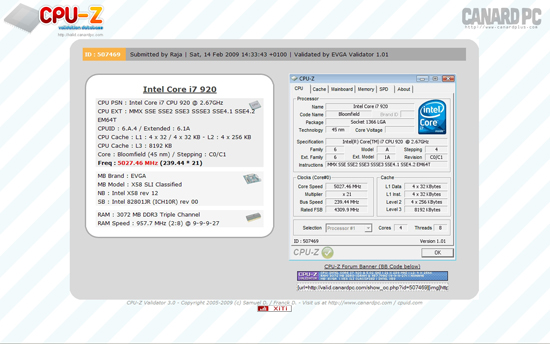
Conventional cooling methods will not show much gain in terms of how far you can push your CPU even with the X58 Classified board in your system. Thermal limitations of the Core i7 will surpass some of the benefits that the improved power circuitry of the Classified board will provide for overclocking users. What you will find is that the more robust nature of the X58 Classified becomes apparent when all slots are completely loaded in a heavily overclocked system.
















22 Comments
View All Comments
rogguy - Thursday, March 12, 2009 - link
this board is mediocre compared to asus ROGEverlong19 - Thursday, March 12, 2009 - link
How can you have a triple GPU setup using dual slot cards and have room for a physics card/sound card?Only way it might be possible is putting the 3rd card in the 4th PCI-E slot, but that would overlap the USB headers etc. The PCI slot gets covered by the 2nd GPU, so any PCI sound cards can't go in there, either.
MadMan007 - Saturday, February 28, 2009 - link
The important thing I take away from this preview has nothing to do with the board itself but rather eVGA's expanding custom software and software/hardware efforts. It's really neat to see a company like eVGA make a push in this direction going well beyond other mobo companies with their basic monitoring software and other graphics rebadgers.MasonStorm - Saturday, February 28, 2009 - link
You could certainly do it, as stated, by plugging one of the dual-slot cards into that last slot, and having it hang over the edge of the board - requiring an extra big case. But another way is to use liquid-cooled versions of the cards, cutting them all down to single-slot size. In any event, it doesn't matter where you place them, since you can use three of the soft, bendy SLI bridge connectors to make your own triple-SLI connection. You don't have to use anybody's firm, fixed triple-SLI connector. Just Google around to see how to use the three individual, soft, bendy connectors.Casper42 - Friday, February 27, 2009 - link
Question on this comment:The slot configuration allows running three dual slot GPUs and a single slot PhysX card or other PCI-E peripheral
In looking at the pictures, this board only has 7 slots total with the x1 being at the top.
If you used 3 Dual Slot GPUs, that would be 3 x 2 = 6 + the x1 = 7
So where exactly are you putting a PhysX card?
The only possibility I see is if you use an 8 or 10 slot Case and stick the 3rd Dual Slot GPU in the very bottom slot such that it hangs off the bottom of the mobo. But in this case, the normal 6 connector Triple SLI Bridge wont reach the 3rd card.
Am I missing something here?
PS: Dont get me wrong, I like the design of the board.
Rajinder Gill - Friday, February 27, 2009 - link
You are right the 3rd SLI card would go in the last PCIe slot, with a dual card overhanging. An SLI bridge supporting this will ship with the retail board.Board dimensions are 310mmX265mm btw. Big case territory.
regards
Raja
cesthree - Friday, February 27, 2009 - link
Remember the awesome 7X0i series of motherboards? Especially the last one with the NF200 on it? It's called a 790i "Ultra" chipset.There are only a few people who ever had problems with the 7X0i series motherboards when using multiple GPU's. Not one person ever complained about things like "freezing" or "hard locking" or "data corruption." Especially not at stock speeds.
Just like there is absolutely no sarcasm in my last paragraph.
What fool would by the "Classified" EVGA motherboard? It's got negligible performance increases. Why go through that much trouble for all of the 5 people on earth who would purchase it and use it with 3-4 GPU's + 30" or bigger monitor.
Mark my words. The NF200 addition to the X58 that EVGA already had going GREAT for them, will bring them problems on the level with the last batch of shoddy, Nvidia tainted motherboards.
I am going to put this in all my sigs from now on:
"Nvidia, for the love of god, please stop crippling motherboards and just stick to GPU's."
Von Matrices - Friday, February 27, 2009 - link
From what I can tell from sources online, the NF200 bridges 16 PCIe 1.1 lanes to 32 PCIe 2.0 lanes. What is there to gain by using the NF200 over just using four PCIe x8 2.0 lanes of bandwidth from the IOH? With the NF200, you get ~4GB/s bandwidth to the IOH per graphics slot compared to ~8GB/s with a native solution, and the bridge adds additional latency, which further reduces performance, and additional cost. Why would EVGA use it then? Are there any advantages to it?Zak - Friday, February 27, 2009 - link
Question. 920 can be easily o/clocked on most boards to 4GHz and peak under 80C under full load using a good air cooler and be perfectly stable. But how long will that CPU and mobo last at these temps and bumped up voltages if used daily? The temps can be addressed by water cooling but how damaging is running CPU at 1.4V, QPI at 1.5V/7.2GHz for long time?Z.
Agoniesfury - Saturday, January 23, 2010 - link
Well I can testify to this comment, and say that I'm an enthusiast and like to buy top rated tech and push their limits, over 8 months ago I purchased a R2E to be used with my 1yr old 920 only bad part was the 920 was a C0 but nonetheless I was able to get to 4.1ghz for benching and everyday stablity "non prime stable", which did fine until 2weeks ago when the board just blinked at me and nothing more, well thank god for rma! So I did decide to upgrade to a classified 760, well in my case I lost some of the bells and whistles that the asus had but was better greeted with the hardware imporvements and design of the evga has. I'm now at 4ghz and climbing 8hrs+ prime stable where as the r2e only was prime stable up to 3.6. So I think both boards are great but the classy is a hair better and hope it lasts!P.S. I've been overclocing for about 10yrs and I never had a chip fry on me it's always the mobo from decay I asume, and the 920 it's self has been through 2 powersupplies and three mobo's.